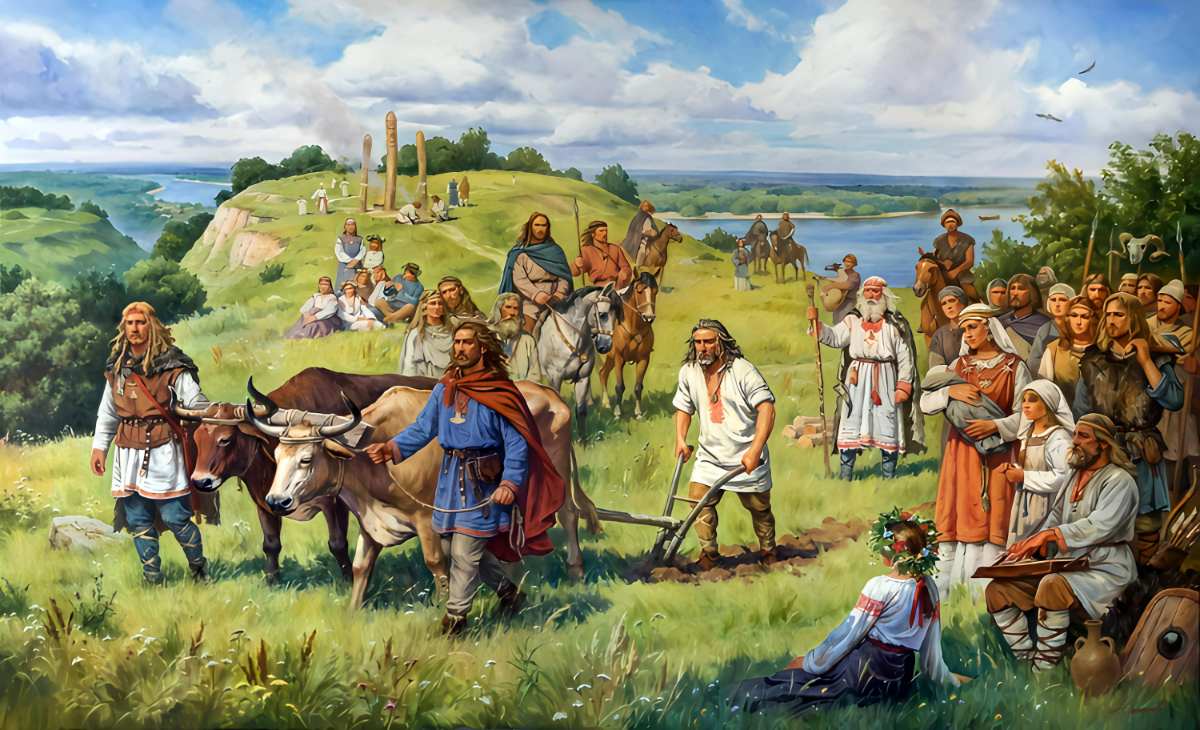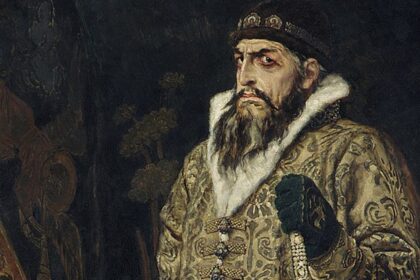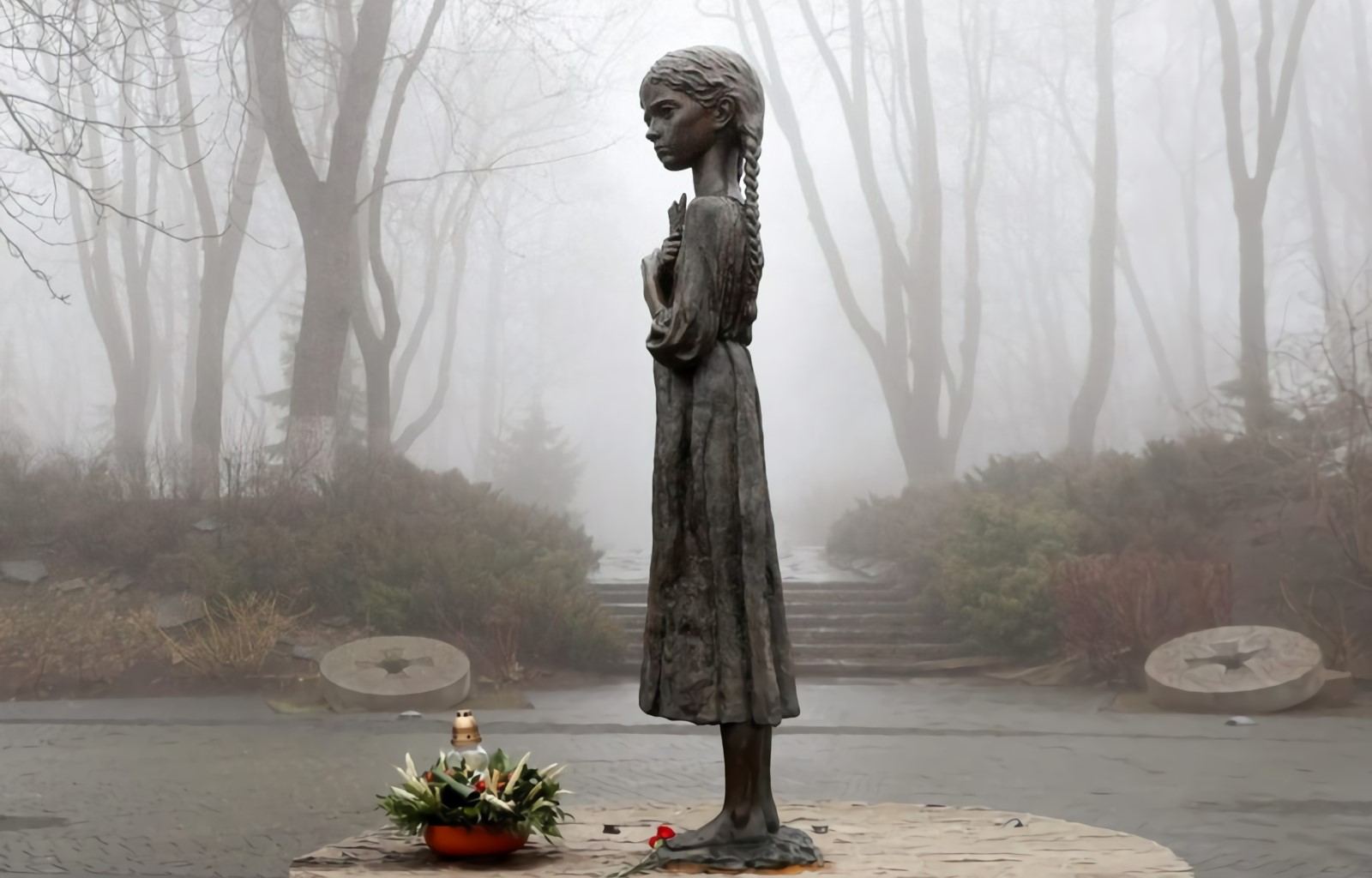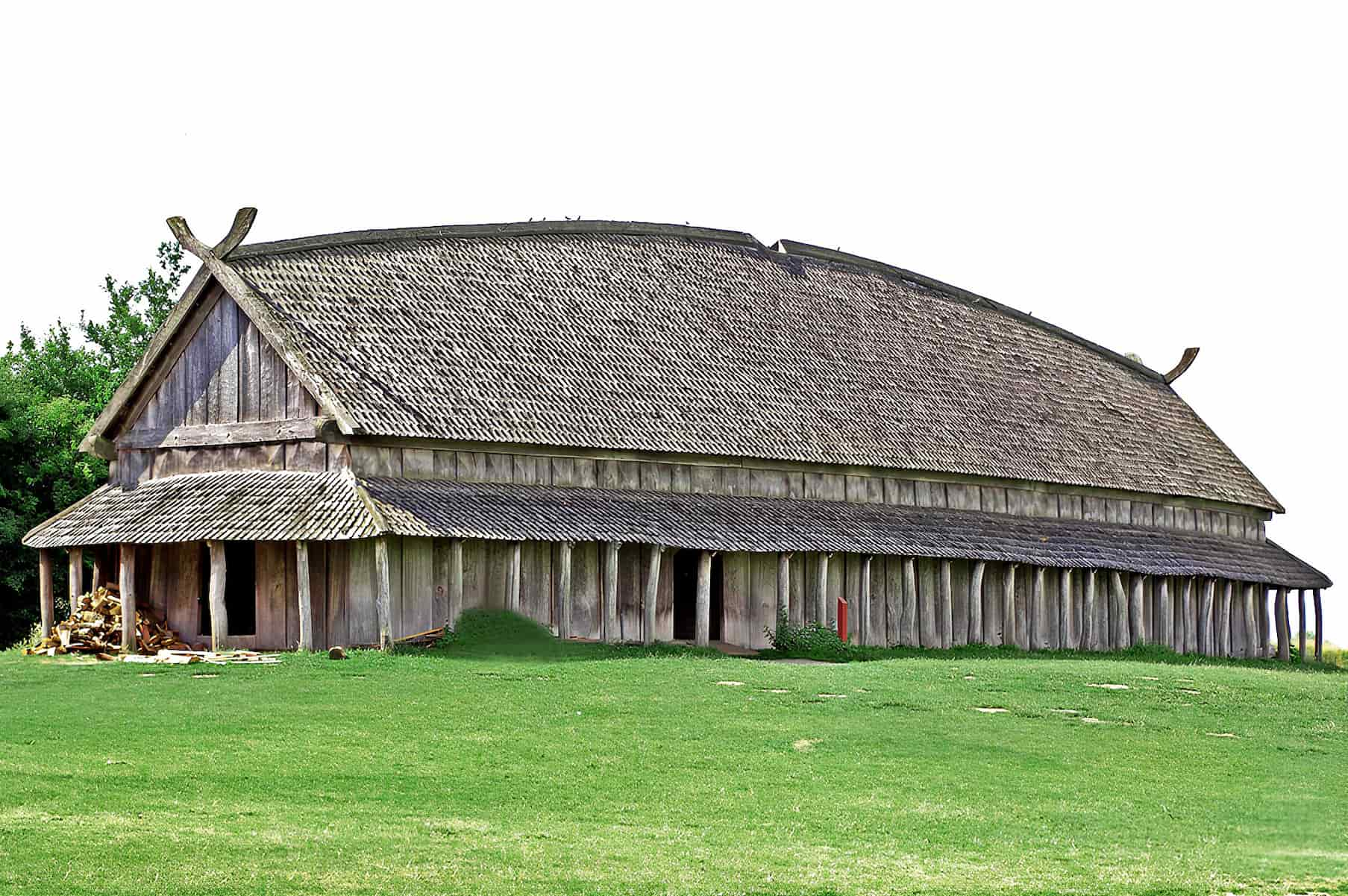Here is everything there is to know about the history of Ukraine. During a televised address in 2022—just three days before Russia invaded Ukraine—Vladimir Putin said, “Ukraine is an inalienable part of our own history, culture, and spiritual space.” He went on to say “modern Ukraine was entirely created by Russia or, to be more precise, by Bolshevik, Communist Russia.” Ukraine, on the other hand, has a distinct past from Russia. Let’s find out more about its rich history.
1. Kievan Rus, 8th–12th century
The Rus’ of Kyiv
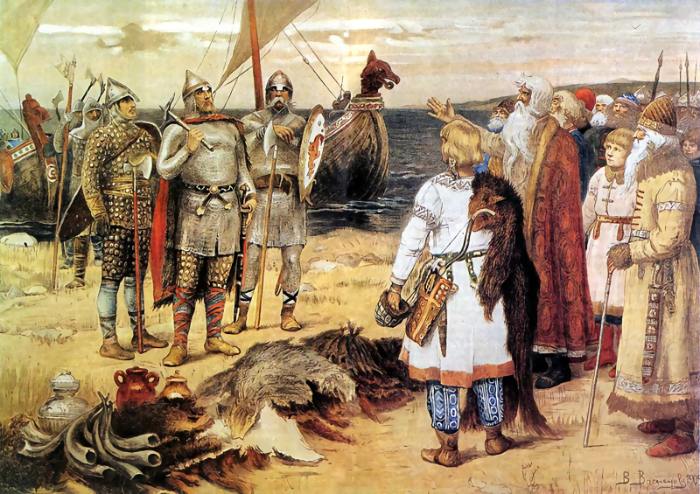
Between 730 and 820, Vikings, the warrior-merchants from Scandinavia, established trading posts in the region of Ladoga, Rostov, and the future city of Novgorod. They are referred to in Greek, Arabic, and Slavonic texts as Rous’ (a Slavic word “Роусь” that originally seems to have meant “rowers” or the Finnish name for the Swedes: Ruotsi) or as Varangians, probably derived from a Scandinavian term meaning “sworn comrades.”
Kyiv was founded in 882 as the seat of the Varangian Rurik dynasty, which gathered Slavic peoples for itself. It was ruled by Prince Igor (Ingvar), who married Olga (Helga) in 945, and after that, the city of Kyiv became the epicenter of a network of Rus’ dominance over the surrounding Slavic tribes thanks to the relations established with Constantinople at this time. The “road from the Varangians to the Greeks” was the name given to this trading route.
Kievan Rus or Kyivan Rus’ was established by Igor’s grandson Vladimir (Valdemar), who reigned from 980 to 1015 and oversaw a huge area stretching from the Baltic Sea south of Kiev (“Kyiv,” as in Ukrainian), to the boundaries of Galicia-Volhynia and the Oka River. Vladimir, who was baptized into the Byzantine Christian (Orthodox) faith in 988, is often credited as the driving force behind the establishment of the Russian Orthodox Church as a part of the Patriarchate of Constantinople.
Kievan Rus’ expansion in an extremely sparse environment caused its breakup in the 12th century into many principalities, each centered on a fortified city; the most important of these were Novgorod, Vladimir, Suzdal, and Moscow, all of which were under constant attack from fearful Turkic nomads. Before the Mongol invasion in 1237–1240, Vladimir’s heirs ruled the lands in question as princes.
Crimea: the crossing point between Kievan Rus and Constantinople (10th–14th century)
Because of its proximity to the sea routes leading to Constantinople and the passages in the steppes, the Byzantine Empire, when it was strong enough, dominated the southeastern coastline of the Crimea (where the Tauri people of the ancient Greeks lived who turned into the Chersonese colony). Crimea was the mountainous part of the peninsula with a sheltered climate and rich port sites.
The position of Crimea was important in terms of controlling the coastal routes leading to Constantinople as well as the passageways through the steppes. This interest grew in prominence with the construction of the “way from the Varangians to the Greeks,” which connected the Baltic to the Black Sea through Kyiv (Kiev).
2. A frontier province of the Mongol Empire
Dominance of the Tatars (13th–16th century)
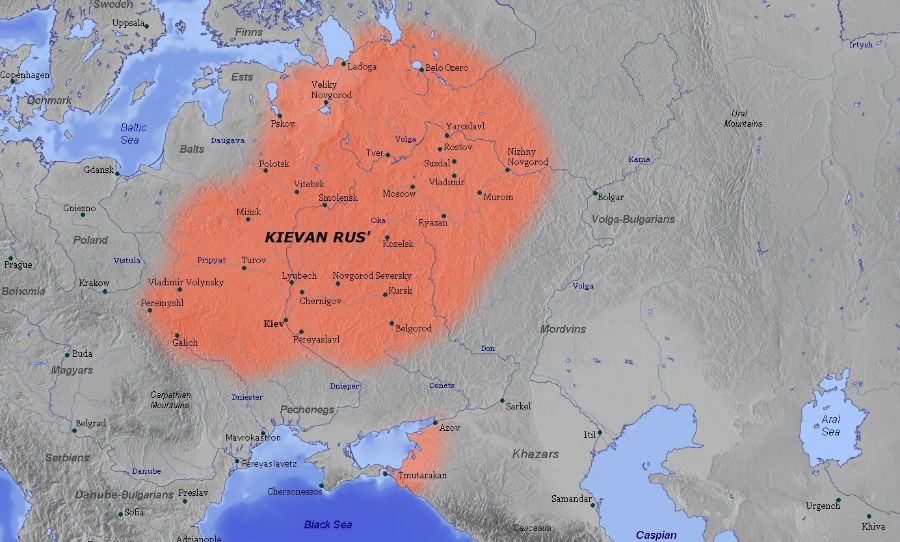
Genghis Khan conquered the nomadic peoples of the steppe in 1206. He then turned his attention to the established empires of China and Central Asia, where he continued his conquests. In 1223, the Kipchak were the last nomads to stand up to the Mongols, so the Khan sent his generals Jebe and Subutai into the Caucasus to locate them. To no avail, the Kipchak united with the rulers of southern Rous’ and they were annihilated by Mongols at the Battle of the Kalka River in 1223.
From 1237 to 1242, Batu, grandson of Genghis Khan, defeated one Russian prince after another and burned the cities of Kiev Rus’, including its capital in 1240. The Russian principalities came under the suzerainty of the Mongol Khans of the Golden Horde. The Mongols are called Tatars in Russian sources, which is the name of a nomadic Turkic people from Central Asia. To the west was the vast Principality of Lithuania.
After two centuries of tax collection cooperation with the Tatars, Moscow declares its independence. After defeating the Emir Mamai in the Battle of Kulikovo in 1380, the great prince of Moscow, Dimitri I, bowed to the Khan Tokhtamysh two years later. With his successors, especially Ivan III, “Russian lands” started to be gathered together (annexations of Novgorod in 1478 and Tver in 1485).
In 1480, Ivan III confronted the fleeing Mongol troops led by Khan Ahmed, marking the end of Mongol rule but not the end of peaceful coexistence between Russians and Tatars. He called himself “Sovereign of all Rous'” since he was a direct descendant of Vladimir of Kiev. His son, Vasily III, submitted the towns of Pskov and Ryazan and pushed back the Lithuanians from Smolensk in 1514 during the fourth Muscovite–Lithuanian War.
Khanate of Crimea, 1449
Tatar horsemen have dominated the steppes along the border of the Russian principalities and Poland-Lithuania since 1240. The Crimean Tatar Khanate emerged when the Golden Horde collapsed between 1430 and 1440, with the southern section of the peninsula staying under the influence of Genoese merchants until the Ottoman invasion in 1475. The Turks took control of the Khanate and made it a Turkish protectorate. The Khanate of Crimea was an ally of Moscow until 1514 when it turned against it.
3. Poland-Lithuania, 14th–15th century
Working together with the Golden Horde was crucial to Moscow’s success. The Muscovite sovereign presented himself as a unifier of the old Rus’ after the 1380 victory against the Tatars at the Battle of Kulikovo. Constantinople’s key position was diminished when it was captured by the Ottomans in 1453, and the union of Lithuania and Poland in 1386 pushed the West toward Catholicism.
It was at the cost of Poland and Lithuania that the Russian Empire expanded to the west. The Cossacks were the people they met there. The Kazan (1552) and Astrakhan (1556) Khanates were conquered by Ivan the Terrible (1533–1584). Ivan the Terrible was the first ruler of Moscow to be given the title “tsar,” which means “new Caesar” in Latin which made him a potential leader of the Orthodox world. This was also the moment when the idea of Moscow being the “third Rome” was first put out.
4. The birth of “Ukraine”: The Cossack era
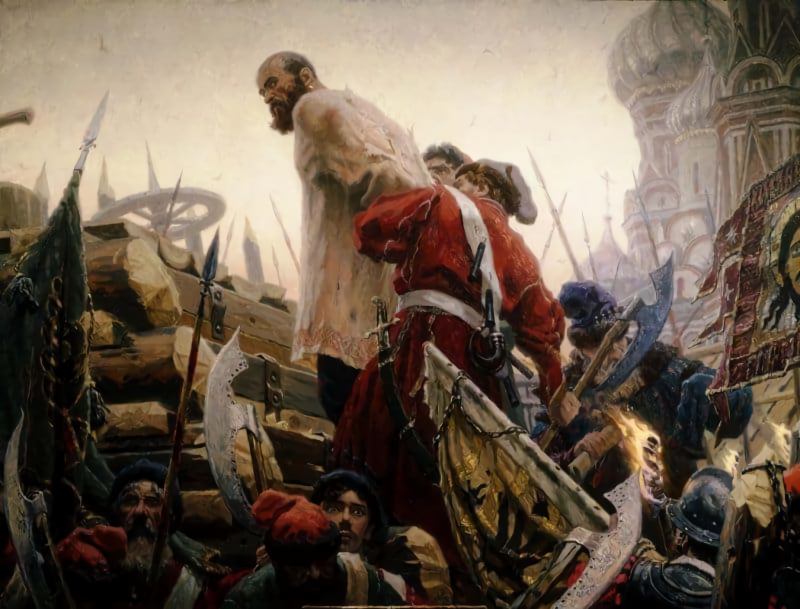
The term “Cossack,” which has its roots in Turkish-Mongolian culture, is used to describe semi-nomadic peoples who live in self-governing military and agricultural communities along the borders of Russia and Poland-Lithuania, particularly in the areas surrounding the Iaik (later renamed the Urals), the Volga, the Don, and the Dnieper rivers. The word “ukraina” first originated at this time from the Old Slavic “оукраина,” meaning “march” which referred to each of the country’s constituent regions.
These communities, commanded by an elected general “Ataman” (meaning “ancestor of horsemen” in Turkic), consisted of free men and independent warriors who survived off of hunting, fishing, and pillaging and were too devoted to their customary privileges. They also accepted peasants who had escaped the expansion of serfdom.
The Razin Uprising (1670–1671) and Pugachev’s Rebellion (1773–1775) are only two examples of many that occurred when the Russian Empire was being formed and their military talents were put to use with autocratic authority to erode the liberties of ukrainas or marches.
5. Russian Ukraine, 17th to 20th century
Rapid growth of the Russian Empire between 1650 and 1800
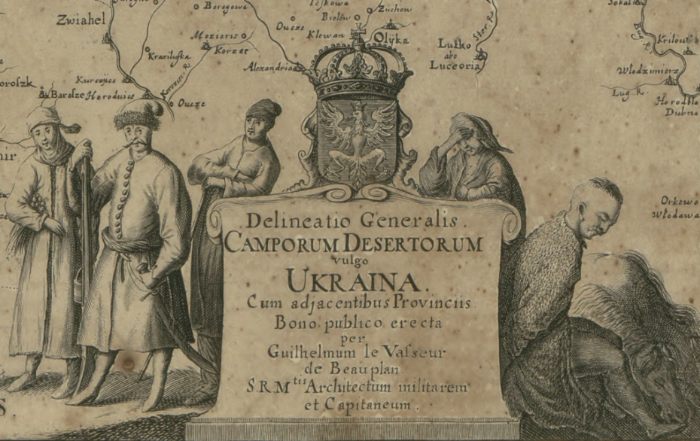
Russia expanded between 1650 and 1800 to become the world’s greatest continental empire, including peoples and languages from all over the globe. Its territory covered an area from present-day Poland to the Pacific Ocean, and from the Arctic Circle to the Caspian Sea and the Black Sea. The Russian language, particularly in government, and obedient service to the tsar were central to the original concept of the empire. It is a modality of governance based on distinction, and it represents a flexible framework.
After 1650, territorial development continued in the same vein as earlier efforts. Eventually, in 1639, the conquering Russian fleet made it to the Pacific Ocean.
The southern Russian progression saw a heightened push into territory inhabited by a variety of Cossack groups. In the 17th century, the Hetman of the Dnieper Cossacks (Zaporozhian) became a de facto head of state, empowered to enlist the help of the Russian tsar in the fight against the Poles. This led to the Pereiaslav Agreement in 1654, whose meaning has been debated ever since. The Russian ruler considered the Zaporozhian and the Orthodox of Poland-Lithuania to be firmly under his power.
Therefore, he was the tsar of “all the Russias,” including “Great Russia” (the region inherited from Ivan the Terrible), “White Russia” (Belarus), and “Little Russia” (a devaluing name for Ukraine). Even though the Zaporozhians, Byelorussians, and Ukrainians believed they had selected a new common ruler, they wanted to maintain their existing level of political, economic, and religious autonomy.
Possible contemporary fault lines in Ukraine may be traced back to the 1654–1667 conflict between Russia and Poland. With the division of Poland (1772–1795), Catherine II became the one to “reconquer” the old Rous’ territories. The part of Ukraine that was to the west of the River Dnieper eventually became part of Russia.
While this was happening, Russian conquering efforts proceeded into Ottoman vassal Tatar territory. After the Crimean Tatars and the Moscow government signed the peace Treaty of Bakhchisarai in 1681, these lands were under Moscow’s firm control, but they became the focus of open conflict between the Russian Empire and the Ottoman Empire at the end of the 17th century and throughout the 18th.
The Don and Dnieper river mouths, as well as the strategically significant Crimean Peninsula, which is home to Tatars and has access to the Sea of Azov and the Black Sea, were the focus of the two nations’ battles in 1711–1713 and 1735–1739. With the signing of the Treaty of Belgrade in 1739, the Russians were finally able to retake the citadel of Azov.
Beginning in the middle of the 18th century, there was a growing interest in the southern lands, driven in part by a desire to secure a foothold on the Black Sea and in part by the need to halt the raids of the Crimean Tatars, who were located close to the imperial marches and remained a significant threat. Russia expanded its frontiers in this strategically important region during its two wars against the Ottoman Empire (1768–1774 and 1787–1791).
As a result of the Treaty of Küçük Kaynarca in 1774, the Russians arrived on the Black Sea, annexed the Crimean Khanate in 1783, and established the port of Sevastopol the same year. The Treaty of Jassy, signed in 1792, put a stop to the second conflict and legalized the acquisition of territory in Moldavia. Odesa, a new city established in 1794 solidified Russia’s influence on the Black Sea.
In addition, beginning in the 1760s, when Catherine II created a formal protectorate there, the Russian advance paralleled or caused the collapse of Poland, which ultimately vanished by the end of the century. Indeed, the right bank of the Dnieper (including the Courland, Lithuania, Belarus, and Ukraine) became part of the Russian Empire during the three partitions of Poland in 1772, 1793, and 1795 between Prussia, Austria, and Russia.
Jews, discriminated residents
There were the Jews, the outcast locals who faced prejudice and had lived on the Black Sea coast since the Middle Ages, and by the end of the 15th century, they had been banned from staying in Muscovy, where they had been living illegally since the reign of Ivan III (1462-1505).
Since they were seen as a threat (particularly the merchants) to Russian markets in the 16th and 17th centuries, trading with Jews was banned. While they didn’t make it to the Moscow fairs, they still had extensive commercial networks and attended other fairs. Bohdan Khmelnytsky, a Cossack from Ukraine who rose to prominence as a resistance leader and national hero, led an uprising in 1648 that resulted in the deaths of tens of thousands of Jews.
About 900,000 Jews, most of whom had relocated from Poland to Ukraine and White Russia (Belarus) between 1772 and 1795, were resident in the Russian Empire at that time. Jewish citizens were forced to relocate to Catherine II’s “settlement zone,” which corresponded to the expanded regions of the empire, except for a few places, such as Kiev, where they were strictly banned. Some Jews, however, including businessmen, manufacturers, physicians, etc., were granted permission to settle in major urban centers and therefore formed a bourgeoisie.
Alexander II’s murder in 1881 put an end to the liberal reforms he had begun. More pogroms erupted until 1884. (a Russian term meaning “to destroy everything” which entered other languages in the 1880s).
Cities in Ukraine were ground zero for the first instances of widespread persecution of Jews in the Russian Empire. An unparalleled magnitude of new pogroms occurred in 1905 and again in 1919–1920. The Ukrainian People’s Republic (1917–1921) is often linked to a time of mass murder of Jews that weakened the Ukrainian national cause, albeit not all of the murders occurred at that time.
The Crimean War, 1853–1856
The Crimean War has its roots in the competition between European countries for the strategic importance of the Black Sea and its straits. Four centuries after the fall of Constantinople, and much to everyone’s astonishment, Nicholas I authorized the military conquest of the Danube princes of Moldavia and Wallachia under the pretense of a theological disagreement between Catholics and Ottomans. As of October 4, 1853, the Sultan declared war.
France and Britain, fearful of Russian expansion, joined the Porte in 1854; the next year, Piedmont and Sardinia did the same. The Turks viewed it as a means of protecting their dwindling empire; the British saw it as a chance to undermine Russia before it became a dangerous competitor in Asia; Napoleon III hoped to reassert French power.
As soon as the Austrian Empire came between the Russian and Ottoman troops, the conflict moved to the Caucasus. From the Black Sea and the White Sea to the Baltic and the Bering Sea, the allies conducted a naval counteroffensive against the Russian coastline. The invasion of Crimea was the first spark that ignited the war. Typhus and cholera wreaked havoc on these already underequipped troops, killing an estimated 500,000 Russians (out of an army of 1.2 million), 100,000 French (out of 310,000), and 20,000 British (out of 98,000).
Russia’s expansionist ambitions were halted when a yearlong siege of Sevastopol resulted in the Empire’s first devastating loss in September 1855. Tsar Alexander II’s military reputation took a hit even though he had preserved the Crimea and only had to give up a portion of Bessarabia (returned in 1878), prompting him to modernize the army.
6. Independent Ukraine 1917–1921

Similar to other European national movements, the Ukrainian one emerged around the turn of the 19th century. One of the most important people in Ukrainian literature, poet Taras Shevchenko’s (1814–1861) writings are essential to the Ukrainian literary canon. He is seen as a victim of Russian authority due to being exiled to Kazakhstan for his political beliefs.
The Eastern Front (1914–1918)
On August 1, 1914, Germany declared war on Russia and entered into World War I, prompting Russia to send soldiers to fight the country. However, the German Army was able to halt the Russian advance at Tannenberg.
The battle in the East was a war of mobility, with the front constantly shifting positions, in contrast to the static combat in the West during World War I. After seizing power in October 1917, the Bolsheviks were unable to expand their influence beyond the territory of the former Muscovy due to the Central Empires.
Polish–Ukrainian War and the Russian Civil War (1918–1921)
The Ukrainian national movement capitalized on the collapse of tsarism in 1917—amidst civil strife and the First World War—to establish a governing body, the Central Council of Ukraine, and to declare Ukraine’s independence. However, brutal warfare occurred throughout the country between various political and military groups including the national forces, the Red Army, anti-Bolshevik White armies, and foreign troops.
Several adversaries, including former allies and counter-revolutionary elements (the “White Russians”), confronted the new Soviet administration when it concluded a separate peace with Germany on March 3, 1918, in Brest-Litovsk. From August 1918 onward, the external powers (France, the United Kingdom, and Canada) that had not accepted the Russian withdrawal and wanted to contain the revolution with a “cordon sanitaire” backed the “White” anti-Bolshevik troops of the inner Volga, the Don, and the Kyiv plains as they attacked the Communist power.
Both the Poles who wanted their territory back and the Ukrainians who wanted to regain their independence called for the return of the eastern region of Galicia, which was once part of Poland before the partitions and then an Austrian state. The war in this area, which was annexed by the Bolsheviks in 1917 to form a popular Ukraine (1917–1920), was unaffected by the armistices that had been signed up to this point. After two weeks of battles in Lwow (Lviv), the Poles lost on November 21, 1918. These child soldiers of the Polish-Ukrainian War are known as the “Lwów Eaglets.”
Fighting between Poles and Ukrainians lasted until the middle of July 1919, with the Poles emerging victorious; a ceasefire was reached on July 17; and on November 21 of the same year, the Poles were given Eastern Galicia, and most significantly, they regained control of Lwow.
When peace was restored in 1921, the Bolsheviks took control of practically all of the formerly Russian-controlled parts of Ukraine (Western Volynia was given back to Poland) and ended the Ukrainian People’s Republic. After the establishment of the Union of Soviet Socialist Republics in 1922, Ukraine, with Kharkiv as its capital, joined the union.
7. A republic of the USSR
There were originally 4 SSRs when the USSR was created in 1922, but by 1936 there were 11, by 1945 there were 16, and by 1956 there were 15 independent republics inside the SSR.
The republics enjoyed some degree of autonomy, but the ultimate authority was in Moscow with the leadership of one party (Political Bureau and Central Committee) and the federal government (Council of People’s Commissars). In addition to having a right to secede, they also had their own councils of people’s commissars, representatives in the soviet of nationalities, and PCs with central committees and sometimes political bureaus, as in Ukraine. Education and justice were strictly Republican concerns.
However, it was acknowledged that these little homelands must serve the vast Soviet Union. After Lenin’s passing in January 1924, the iron rule changed to fealty to Stalin, who had been able to transform his role as General Secretary of the Party since 1922 into a true autocrat.
Stalin said in 1931, “We have to catch up, otherwise we will be beaten.” The violent uniformity of the intricate tapestry of historical lives and cultures was facilitated by the collectivization of the countryside, the forcible replacement of elites, and the mass population relocation.
The Great Famine of 1931–1933
Stalin’s regime aimed to take agricultural resources for the cities and export them with collectivization, but the burden of compulsory deliveries left few resources for families in kolkhozes, the collective farms. In 1932, three out of four households received less than 220 pounds (100 kg) of grain per year, compared to 660 pounds (300 kg) in the 1920s.
Many herders refused their forced sedentarization and the collectivization of livestock, leading to widespread starvation in Kazakhstan by the spring of 1931. By 1932, poor harvests in Western Siberia and Kazakhstan further weakened an already fragile productive system and put additional strain on the resources of Ukraine, Kuban, and the Volga regions.
Entire areas were rising up in Ukraine as the farmers did not want to part with their land, their crops, or their equipment. Ukrainian villages fled to Poland in masses, headed by women and children. However, for Stalin in Moscow, this was only the treachery of counter-revolutionaries, not the food and humanitarian crises that the coercive policies caused.
As a result of public opposition, the Stalinist government intensified its policy of compulsory levies and cracked down on the districts that did not comply with the collection plan. This included cutting off the supply of food and manufactured goods, imposing fines and jail time, and seizing the last of the nation’s food reserves.
The obligation to give the portion of the crop set aside for seeds, which was necessary to assure the next harvest, made the Great Famine of 1931–1933 worse. Peasants who attempted to run from starvation by relocating to cities, where rationing had been instituted, were apprehended by specialized Russian patrols. The first group of people to be deported in bulk to the Gulag is known as the “kulaks.” The word originally meant “well-off” peasants but it later applied to all who simply rejected collectivization.
Holodomor, a potential genocide
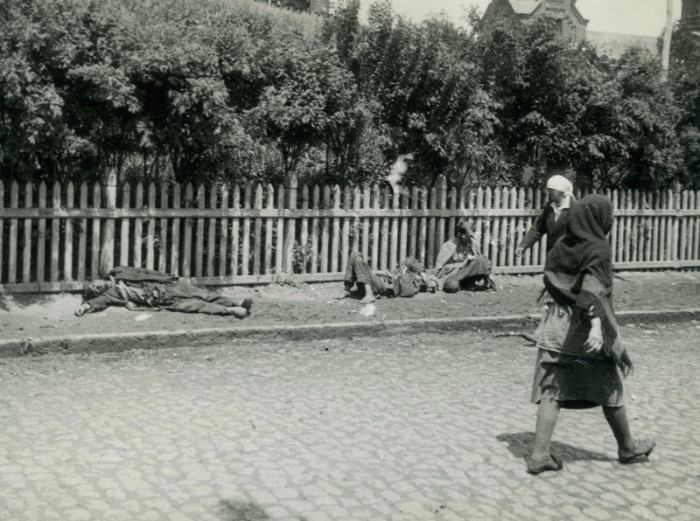
4 million Ukrainians and 1.5 million Kazakhs died as a result of the famine. Although it was a catastrophe for the population and an agricultural calamity, the Kremlin saw it as a chance to securely anchor the border republics. To make Ukraine a fortress, any possible disloyalties must be eliminated, whether they originated from intellectuals and communists who were too patriotic and not particularly respectful of the general secretary, or from peasants who were too committed to their property.
Since the fall of the USSR in 1991, the tragedy of the 1932–1933 famine played a central role in the political life of the new Ukrainian state, marked by the confrontation between supporters of a break with the USSR (and then with Russia), who were in the majority in the western part of Ukraine, and the supporters of maintaining close ties with the “big brother” who were in the majority in Russian-speaking eastern Ukraine.
The term “Holodomor,” which combines the words golod, “hunger” and mor, the root of the verb moryty, which means “to exhaust,” “to let suffer without intervening,” and “to kill by deprivation,” was coined in Ukraine to describe the mass starvation death of Ukrainians of an intentional nature. The Holodomor was not only at the center of the political debate but also became a crucial part of the post-Soviet Ukrainian national identity.
The “Orange Revolution” of President Yushchenko was dominant in the Ukrainian Parliament at the time, which decided to formally acknowledge the famine of 1932–1933 as a genocide committed by the Stalinist dictatorship against the Ukrainian people in November 2006. Currently, 24 nations (including the United States, Canada, Poland, the Baltic States, the Vatican, Brazil, and Argentina) recognize Holodomor as a genocide; however, neither the United Nations nor the European Parliament has done so. In 2008, the European Parliament did, however, declare the Holodomor a “crime against humanity.”
However, in Russia, very few historians who study the famines of the early 1930s unanimously reject the thesis of genocide and the national specificity of the Ukrainian case.
World War II
In violation of the Nazi-Soviet Pact, Nazi Germany launched Operation Barbarossa on June 22, 1941, which included the mobilization of 4 million soldiers, 3,300 tanks, and 5,000 aircraft. The Red Army was taken by surprise and unprepared by the sizable troops. Hitler wanted the Russian campaign conducted swiftly. “I need Ukraine,” Hitler said, “so no one can starve us out again, as they did in the last war,” in a 1939 interview with historian Carl Jakob Burckhardt.
On July 1, the German troops arrived in Minsk. Leningrad was under siege in September, and on September 19, Kyev or Kyiv was captured along with tens of thousands of captives.
After the Soviet Union was invaded, the Final Solution to the Jewish problem—which is to say, the deliberate killing of Jews—was put into action. The Einsatzgruppen, paramilitary death squads directed by members of the Reichssicherheitshauptamt, the Reich’s top security agency, were given this order. Out of the four Einsatzgruppen, two were active in Ukraine. The forces stayed as close to the Wehrmacht (Nazi armed forces) as they could.
The first Jewish deportations to ghettos in the Baltic States and Belarus began in the middle of October 1941, moving people from the Reich and other parts of Western Europe. A total of 500,000 people were killed in the spring of 1942. In 1941 or 1942, most of the Soviet Jews were killed. Even though the SS and the police were primarily in charge of carrying out the extermination campaign, local volunteer battalions and regular Wehrmacht troops also played a significant part in these killings. With their mostly logistical support, almost 34,000 Jews were killed at Babi Yar, close to Kyiv, at the end of September 1941. Prisoners of war were also killed along with the Jews under the excuse of a bombing that destroyed the 6th Army headquarters.
Ukrainian nationalists hiding out in Germany as part of the Organization of Ukrainian Nationalists (OUN) attempted to leverage the rapid Wehrmacht advance in Ukraine to cement their control over the land. There was an initial impression that their plan had worked. When the German troops arrived in rural areas, they were typically greeted with gifts of food, milk, fruit, and even flowers, in stark contrast to the chilly reception they got in the city, where sizable Jewish and Russian communities lived.
One of the primary justifications of modern Russian propaganda is based on this dark period in Ukrainian history, which was defined by the reconciliation between nationalists (particularly Stepan Bandera, accused of countless war crimes) and the Nazis.
The Nazis, however, rapidly destroyed this temporary peace. On July 13, 1941, when addressing the SS at Sczeczin, Heinrich Himmler classified the Slavs as “a population […] whose physique is such that they can be slaughtered without feeling either pity or compassion.”
A fortnight later, Hitler, who intended to make Crimea a German Riviera for the Aryan master race, proclaimed: “The Ukrainians are as lazy […] as the Russians. Like the Russians, they belong to the “family of rabbits” and must be treated as such. The German General Staff stated that “the Bolshevik soldier has lost the right to be treated as an honest soldier.”
In the event of any kind of hostage revolt or sabotage, all captives were brutally murdered. By the end of October 1941, the whole Ukrainian town of Obukhivka had been burnt to the ground and its inhabitants had been executed by firing squad. Following the orders, Wehrmacht troops sacked the homes of Ukrainian farmers and town residents, killing anybody who tried to protect their goods.
The seized Ukrainian territory was now partitioned. The region’s northernmost part, Eastern Galicia, was part of the General Government, Polish province was ruled by Hans Frank. Erick Koch ruled over the remainder of Ukraine as Reichskommissariat (Reich Commissioner.)
The local farmers and urban intellectuals were targeted by Nazi propaganda that attacked Jews and Communist political commissars to garner their support. But, from protesting against hunger to struggling while walking, any of these were sufficient grounds for immediate execution. Thus, the widespread terror caused by the occupation swiftly turned the majority of the people against Nazi Germany.
The Ukrainian Insurgent Army (UPA) and the Soviet partisans began working together to harass the Wehrmacht and derail its trains in the summer of 1942, despite being old enemies.
The Germans, unprepared for a lengthy war, were halted before Moscow by the end of 1941 thanks to the onset of winter, the organizing of the Russian resistance, and the involvement of troops from Siberia. The Red Army pushed westward, taking advantage of German vulnerabilities. Kyiv had been retaken on November 6, 1943. And then, German forces were expelled from Ukraine in March 1944, and from Crimea in May.
Following the October 18th, 1944, crossing of the Carpathians by the Red Army’s 4th Ukrainian Front, the people of Subcarpathian Ruthenia, a region that had been part of the Hungarian Crown before being annexed by Czechoslovakia in 1920, quickly realized that they would be living in a Ukrainian-dominated Soviet Union. But neither Eastern Galicia nor Subcarpathian Ruthenia had ever been a part of the Russian Empire. These regions, the final parts of Ukraine, were now a part of the new empire’s western frontier.
The socialist republics of the USSR
Within the Soviet Union itself, the war also had a profound effect on the established order of things. The other Union countries looked to the Russians as their leader after Generalissimo Stalin appointed the country as such. The Belarusians and Ukrainians, the war’s primary victims and driving forces of resistance, were successful in having their republic granted a seat in the General Assembly of the United Nations at Stalin’s insistence and in direct violation of international law. While their republics were destroyed, the Crimean Tatars, Chechens, and other North Caucasus peoples were accused of working with the Germans and deported to Central Asia.
After Stalin died in 1953, an urban and educated Soviet populace emerged, far distant from religion, speaking Russian, and considering it normal for women to have a job. This was an acculturation and assimilation process that neither the Tsars nor Lenin had succeeded in carrying out.
Russian became the language of choice in Belarus and Ukraine after the gift of Crimea in 1954 boosted the number of Russian speakers in both countries.
Despite Homo sovieticus‘ homogenous lifestyle, the underlying national identities of Soviet people were never forgotten. The Russian regime’s modernization and decentralization efforts, as well as the emergence of the opposition, actually bolstered these trends.
Ukraine, Tatarstan, Georgia, Moldova, and Lithuania all participated in the “parade of sovereignties” between 1989 and 1991, a movement that exploited the Soviet Constitution and the ability to secede to declare independence from the larger Soviet Union.
The Kravchuk Era, 1990–1991
Despite the efforts of the Rukh (People’s Movement of Ukraine), which had been formed on the initiative of former dissidents (L. Lukyanenko, V. Chornovil, and Ivan. Drach), and which had been joined by members of movements for the defense of the Ukrainian language and ecological associations, particularly active since the Chernobyl nuclear disaster in April 1986, the Soviet apparatus in Ukraine resisted change until the end of 1989.
A question that arose as a result of this incident was whether Ukraine, the second most populous Soviet republic, was destined to become the “nuclear wasteland” of the USSR after its resources had been overexploited under Stalin.
The Ukrainian Communist Party, led for 15 years by Vladimir Shcherbitsky until being succeeded by Leonid Kravchuk at the end of 1989, bowed to pressure from the large strike of the Donbas miners in the summer of 1989. The second group deftly used the Ukrainian national card to stave off the Rukh’s advance. In March 1990, after municipal elections that went in the communists’ favor, Kravchuk was placed at the helm of the Supreme Soviet of Ukraine.
Leonid Kravchuk was well-connected to Boris Yeltsin, the party’s star in Moscow. These two men, as leaders of the two most important Soviet republics, were destined to play pivotal roles in the Soviet Union’s ultimate crises.
There was a developing rift between Mikhail Gorbachev and Boris Yeltsin in the last year of the USSR’s existence. Boris Yeltsin advocated a swift transition to a market economy (“500 Days Plan”), whereas Mikhail Gorbachev favored a more gradual approach to end the state control of the economy and usher in free market principles. The second point of argument was the scope of the proposed New Union Treaty.
The republics were provided with a text on November 23rd, 1990. The discussions were attended by all the countries except for the Baltic States and Georgia. The document granted new rights to the republics and all references to socialism were removed. The Union of Soviet Sovereign Republics replaced the Union of Soviet Socialist Republics and while the treaty did offer additional privileges to the republics, the federal prerogatives stayed quite powerful.
The bilateral agreement between Boris Yeltsin and Leonid Kravchuk, signed on November 20, recognized the sovereignty of both Russia and Ukraine and committed them to economic cooperation.
A referendum on the proposed new Union treaty was conducted in March 1991 in 9 of the 15 republics that had not yet seceded, and it was accepted by an average of 77% of voters (70% in Ukraine), giving Mikhail Gorbachev the upper hand in the struggle between the two men. The vast majority of native Soviets still had strong ties to the federation.
Boris Yeltsin then decided to hasten the collapse of the Union and Russia’s subsequent march toward independence. On June 12, 1991, he received 57% of the vote in the first round of voting for President of Russia. He gained more credibility when pitted against Mikhail Gorbachev, who had been indirectly elected President of the USSR the year before.
Worried about these “populist” developments, and disgusted by Boris Yeltsin’s forced march towards the market economy, the most conservative groups incited a putsch on August 19 and 21, 1991, which failed miserably in the face of Boris Yeltsin’s determined resistance, supported by the population of Moscow and Leningrad.
As the putsch failed, the legitimately elected Russian president triumphed against his antagonist, who had been aiding the coup from his vacation spot on the Black Sea. Mikhail Gorbachev stepped down as CPSU general secretary, and Boris Yeltsin put a halt to the party’s operations. The last nail in the coffin was driven home by Leonid Kravchuk when the Ukrainian Parliament declared the country’s independence after a referendum on December 1 (in which 90% of voters said “yes”).
In a conference a week later in Belovezha (on the border of Belarus and Poland), Boris Yeltsin, Leonid Kravchuk, and Stanislav Shushkevich (the President of Belarus) approved a paper declaring that there is no longer any legal or political basis for the Soviet Union to exist. A Commonwealth of Independent States (CIS) “open to all states of the former USSR” was established instead. The foundation contract of the Commonwealth of Independent States (CIS) was signed on December 21 by 11 of the 15 former Soviet republics (excluding the Baltic States and Georgia) in Alma-Ata, where Mikhail Gorbachev was not present.
The procedure to formally terminate the USSR and the departure of its president was finalized on December 23 when Mikhail Gorbachev met with Boris Yeltsin. On December 25 at 7 p.m., Gorbachev read a short farewell address he had prepared for television. The Russian tricolor flag and the crimson flag are raised atop the Kremlin towers simultaneously. Thus, 1991 goes down in history as the peaceful closing to a period that started in bloody revolutionary violence in October 1917, exactly 74 years before.
8. Ukraine’s independence

Ukraine, 1991
The territory of independent Ukraine in 1991 was the consequence of a violent history. The western Ukrainian territories were annexed between 1939 and 1945 at the cost of Poland, Romania, or Czechoslovakia, and the eastern regions were remnants of the previous Russian Empire. Nikita Khrushchev gave Crimea to Russia in 1954, and Russia seized it in 2014. Conflicts between separatist groups and the Ukrainian national government are still ongoing in the Donbas.
The “Orange Revolution”, 2004
Comparing Ukraine to the Baltic nations, for instance, the uniqueness of Ukraine might be attributed to the communist authorities’ appropriation of certain nationalist elements. Thus, Leonid Kravchuk, a prominent member of the Ukrainian Communist Party, became the first president of the republic to be chosen by universal suffrage after independence was granted by referendum on December 1, 1991, with more than 90% of the votes.
The outrage brought on by the election fraud, and a condemnation of the elites founded during the Soviet period who were now ruling the nation’s oligarchic clans were among the factors of the protests of November and December 2004 in Kiev known as the “Orange Revolution.” Even while it marked the presence of a “nation,” these protests were still more political than patriotic.
Russo-Ukrainian War, 2014
A thousand protesters assembled in Lenin Square on February 22, 2014, in Dnipropetrovsk, a major industrial city in eastern Ukraine. They encircled an impressive statue of Lenin that was placed there in 1957 to commemorate the 40th anniversary of the October Revolution in order to disprove it. The police, who were mostly inactive, and the few communists who were there, failed to stop the protesters. After seven hours of work, Lenin was knocked off of his perch at 1 in the morning.
The next day, it turned out that Viktor Yanukovych, the president of Ukraine, had just hurriedly departed the nation. Since February 20, there were 82 fatalities had been mourned in Kiev and since late November 2013, hundreds of thousands of protesters demonstrated against the government’s unwillingness to sign a cooperation agreement with the EU to promote a relationship with Russia.
Some members of this movement, soon to be known as the “Revolution of Dignity” (or Euromaidan), raised the matter of the Soviet legacy in Ukraine more forcefully than the “Orange Revolution” ten years ago. The Lenin statue, which had stood at the foot of Shevchenko Boulevard in Kiev since 1946, had been demolished in December at the behest of deputies and supporters of the nationalist Svoboda Party. Turning away from the Yanukovych administration and the elites educated during the Soviet period meant a major de-communization and de-Russification of Ukraine for an increasing number of Ukrainians.
The mining region of Donbas, one of the USSR’s economic and symbolic hubs, had become a border area between Russia and Ukraine in the years after independence. The place names from the Soviet era were still very much in use in these areas, there were still many ties to Russia, and Russian continued to be the language of choice. The events of 2014 put the locals to the test, revealed crucial realities, and pushed the local people to choose a side. The Russian invasion of Crimea, as well as the crisis and subsequent fighting in the eastern regions backed by Moscow, heightened public awareness.
Invasion of Crimea, 2014
Crimea was a part of independent Ukraine at the time of the dissolution of the USSR. The latter gave this mostly Russian-speaking area some autonomy, although, among Russians, Ukraine was known as “Little Russia.” Additionally, agreements with Russia permitted the partition of the former Soviet Black Sea fleet and the granting of a lease to Russia for the port of Sevastopol, which was established in 1783 after the invasion of Crimea by Catherine II.
Russian soldiers occupied the Crimean Peninsula as the pro-Russian president Viktor Yanukovych was ousted in Kiev after the protests in February 2014. After a self-determination referendum that the international community did not recognize, Russia annexed Crimea in March 2014. Eastern Ukraine, home to a sizable Russian population, witnessed the movement’s expansion. The separation of Donbas led to a war between the Ukrainian government and the rebels supported by Russia. The issue of Russian gas became a crucial problem for Ukraine.
Donbas: the upsurging
The Donetz river basin, a sizable coal-mining region, was integrated into the Russian Empire at the end of the 17th century and served as the focal point of Russia’s industrialization beginning at the end of the 19th century. During the Soviet era, propaganda heavily emphasized this region as the nation’s symbolic heart. The status of the area was altered in 1991 when Ukraine gained independence. The aging coal-mining sector was affected by economic change, and the Russian-speaking miners felt devalued and excluded.
The Donbas opposed the Kievan Revolution in November 2013. Donetsk and Luhansk were taken over by separatist activists in April 2014, and in May they proclaimed their independence after holding referendums that Kiev deemed invalid. Local militias commanded by Russian mercenaries engaged in combat with “volunteer battalions” and the Ukrainian army had initiated a military operation. 13,000 individuals lost their lives in all and at least 1.5 million people were forced to flee their homes as a consequence of the war. The war was “halted” by the Minsk agreements in February 2015 without resolving it. Despite not having a formal presence in Ukraine, Moscow is known to have supported the rebels.
De-Russification along with de-communization
The Russian annexation of Crimea in February 2014 and the subsequent crisis and conflict in the eastern territories, in which Moscow supported autonomy, hastened the de-communization and de-Russification.
While rivals of the Maidan often mobilized symbols of Soviet nostalgia (such as the orange and black Ribbon of Saint George, which represented the Red Army’s triumph over Nazi Germany), the Soviet elements of Ukraine were now fading. Thus, the year 2014 elicited a strong sense of national consciousness in Ukraine. The deconstruction of Lenin’s monument in Kharkiv in September 2014 was proof of this. While the mayor, Gennady Kernes, threatened anybody who attempted to touch the memorial a few months before, he relented. The conflict was concluded.
Four pieces of de-communization legislation were enacted by the Ukrainian Parliament in May 2015 with the Institute of National Remembrance’s help. The dismantling of Soviet statues and Russian street names, the complete opening of the Soviet archives, and measures in support of the Ukrainian independence fighters were among them. Between 2013 and 2016, 965 statues of Lenin were removed from public view in Ukraine. This event was referred to as the “fall of Lenin.” 52,000 streets were renamed, and 986 localities and 32 cities changed their names, including Dnipropetrovsk, named after the Bolshevik leader Grigori Petrovski, which is now called Dnipro.
Russian interference in Crimea and Donbas has given these reforms a new meaning, necessitating the removal of any references to Russia as well. Before being renamed the “Northern” bridge in 2018, Kiev’s Moscow Bridge was first repainted in the blue and yellow of the Ukrainian flag. The bridge spans the Dnieper. Both the square and the avenue of Moscow received new names, with the second inheriting the Ukrainian nationalist Stepan Bandera’s name, which is detested by Russians. According to the idea that is becoming more prevalent in Ukraine and tends to paint the past as a time of Russian colonialism, de-communization is now being de-Russification.
References
- Cover picture: Артур Орльонов, “Kyi, Shchek, Khoriv and Lybid found the city of Kyiv, 482, modern Ukrainian painter“, CC BY-SA 3.0.
- Orest Subtelny, “Ukraine: A History.“
- Paul Robert Magocsi, “A history of Ukraine.”
- Anna Reid, “Borderland: A Journey Through the History of Ukraine.”
- Kyiv Post, “Ukrainian Insurgent Army: Myths and facts.”


